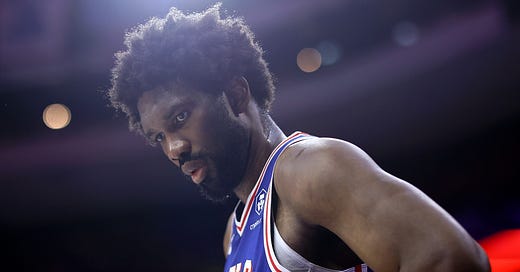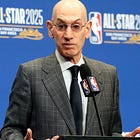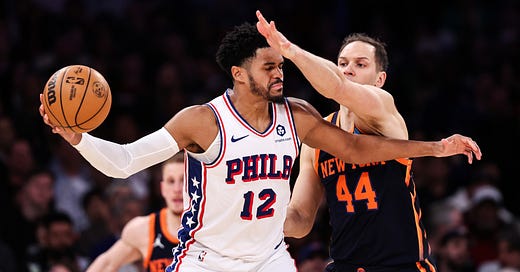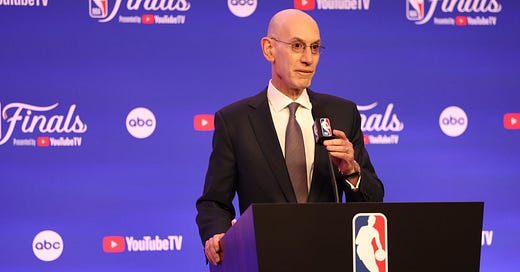
What Would a Role-Player Version of Joel Embiid Look Like?
MOC looks at a middle-case scenario for Joel's post-surgery future.
On Wednesday night, news broke from ESPN that Joel Embiid is set to undergo an arthroscopic procedure on his left knee to address the lingering issues that he’s been having since his meniscus tear in January of 2024. While we don’t know the full details of the surgery, Shams did report that Embiid will be re-evaluated in six weeks, which suggests that this procedure is much more mild than some of the possibilities that were being discussed over the past few months. It appears to be a minor clean-up procedure that will not prevent Embiid from being ready to play next season.
In some ways, it’s a relief just to have a conclusion to this news cycle – it had been five weeks since the Sixers shut him down for the season – but it also remains hard to believe that this surgery will be some sort of silver bullet that gets Embiid back to being the MVP-caliber player that he was before his injury.
If you look at the history of star players in the NBA who have had lingering problems for more than a few months after a meniscus tear, it’s not a very encouraging track record; you’ll only find a handful of players who had serious issues for many months after their injury, and later bounced back to be roughly the player they were before their injuries. Russell Westbrook in 2013 and Amar’e Stoudemire in 2005 are the two most encouraging examples there – both players missed the better part of a year after a meniscus tear and later went on to make full recoveries after follow-up procedures.
Of course, there are also players who tore their meniscus, never fully recovered, and barely ever played basketball again. Chandler Parsons and Andrew Bynum fit that description.
But for many players, there’s a bit of a middle ground in which they are able to continue their career, but in a different capacity. At this point, I think that’s the best we can reasonably hope for with Embiid – counting on him to be the pre-2024 version of himself is just not a safe bet, but there remains plenty of reason to believe that he could shift into a different phase of his career in a different role and with a different play style.
Even as he continues to decline from his peak mobility, Embiid is still a net positive every single time he sets foot on an NBA court. While his scoring output and overall impact this year were far cries from his peak, Embiid still looked like an All-Star caliber player in most of his 19 games this season.
From a play style perspective, the biggest shift that Embiid will need to make as his career goes on is transitioning from a play creator to a play finisher; he should continue to decrease his post-ups and isolations, and should instead rely on pick-and-pop jumpers and drives to the rim off of short rolls after Maxey and McCain garner attention. He remains one of the best mid-range shooters and one of the most skilled big men in the league – those two things will continue to carry immense value even as a role player.
Defensively, Embiid will have to play a deep drop coverage (something he’s spent most of his time doing, anyway) and limit the degree to which he chases smaller players around on the perimeter. His size, timing, and IQ will allow him to always remain an effective rim protector, even if he can’t fly in from long distances to alter shots like he’s been able to for most of his career.
In an ideal world, Embiid’s role would be something similar to Brook Lopez, who also transitioned from a post-up, score-first big man into a 3-and-D type role once he got to Milwaukee. Lopez’s durability likely isn’t a fair goal for Embiid — he has played 70-plus games in four of the past five seasons – but the overall concept of his role is a good aspiration.
I really believe that even in his hampered state, the biggest battle Embiid faces isn’t adapting his game, it’s just managing his health such that he’s able to stay on the court with enough regularity. He’ll have to find a way to play the most minutes possible in as many games as possible without passing the threshold of what his knee can tolerate before it swells up and becomes overly painful.
Ideally, shifting his role would allow him to play starter-level minutes for 40-50 games – but there’s a chance that Embiid’s days as a starter are simply over. Still, it wouldn’t be the worst possible outcome if Embiid plays 20 minutes per game twice a week as a bench player and rests whenever the knee becomes troublesome. Think Bill Walton on the ‘86 Celtics, except of course for the slight caveat that the team would be likely somewhere around .500.
In some sense, Embiid transitioning to being a bench player would help with the mental framework both for him and the fans, in that no one would place the burden on him of being The Guy anymore. He could settle into life as a fun side character here to help the young core develop, with no expectations of carrying the franchise. Taking the pressure off of him to that degree would be refreshing for everyone involved; not having to panic every time he falls or read into every medical update too deeply would be a nice change from what life has been like for the past 14 months.
Still, from a realist’s perspective, things aren’t likely to be that clean – as much as I’d like it, I don’t really expect Embiid to settle cleanly into a 20-25 minute per night role and be a drama-less, kick-ass role player. I’m ready for this to have a messy, unpredictable outcome, as things always seem to be with Embiid – it wouldn’t shock me at all to see a month of elite play from him to start next season, followed by two months on the shelf, followed by a month of underwhelming play, followed by another surgery. I’d hate to see that, but if this season is any indication, the health of Embiid’s knee is likely to be inconsistent and hard to manage.
Generally speaking, I think that human beings are only really capable of understanding three probabilities: zero percent, fifty percent, and one hundred percent. Similarly, I think we can all only really grasp three real outcomes for Embiid: that he barely ever plays again, that he finds second life as a lower minute role player, or that he bounces back to become the player he was before his injury.
In reality, this is likely to play out in a way that is extremely messy. But on the bright side, if we do get something in the realm of that 50th percentile outcome – in which Embiid finds second life as a role player – I think it would be a fun way to close out his career that is easy for both him and the fans to enjoy.
Mike O’Connor is the best O’Connor in basketball writing. Previously of The Athletic, you can find Mike on Twitter @MOConnor_NBA. Mike’s writing is brought to you by Body Bio, supplements based on science, focusing on your gut and brain health.
















I think it's hard to compare Joel's situation to Russel Westbrook and Amare because, while they all have had meniscus issues, the three of them have each had different follow up procedures to address them.
Russ had a meniscus repair done, which is the 'full' procedure where the tear is sewn back together and has the longer rehab time (8-12 months). Amare had a microfracture surgery, which is another long-term solution with a 9-12 month recovery. Joel had the menisectomy done, which just cuts all of the disconnected meniscus out of the knee and basically signals 'we are sacrificing long-term prospects to get him back on the court as soon as possible'.
Joel's procedure was 'successful' in that it got him back on the court as soon as possible, but we are now in the 'sacrifice long-term prospects' phase. There is MUCH less opportunity for future recovery now due to the meniscus being removed as opposed to repaired (Russ) or partially-regenerated (Amare). I know the doomer take is the easy way out, but from a medical perspective it seems like we made our bet on Embiid being able to carry last year at the cost of the future. And obviously that didn't pan out.
Setting everything else aside, Amare was finished at age 30 and Westbrook was minimum contract journeyman after age 32. Embiid will turn 32 next season and make $250m the next four seasons… yeah so if they are the best case examples still doesn’t portend anything good for the Sixers nor Embiid.